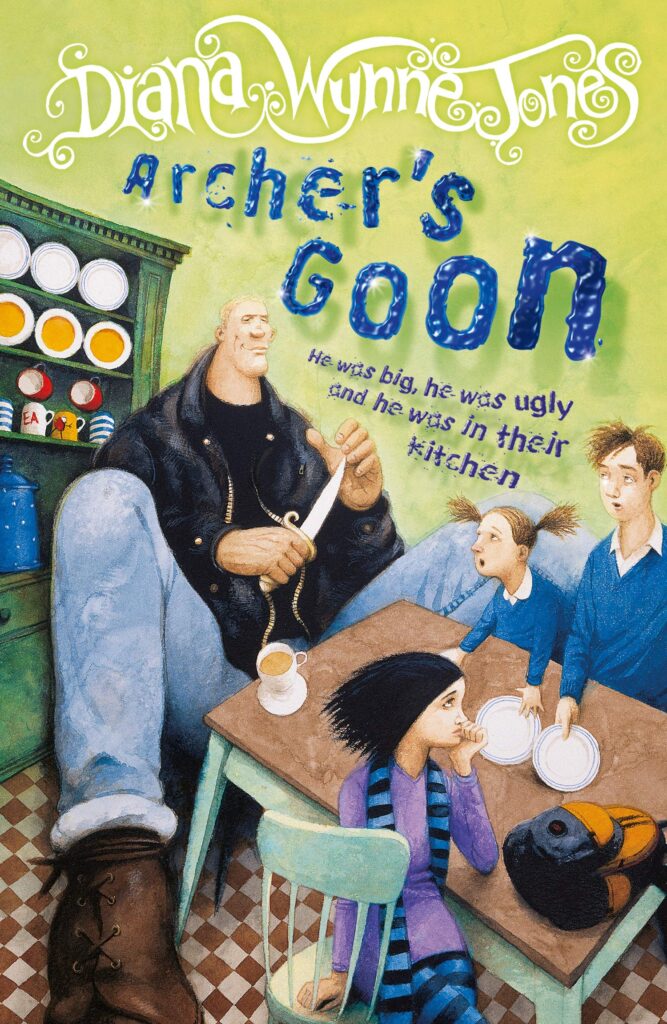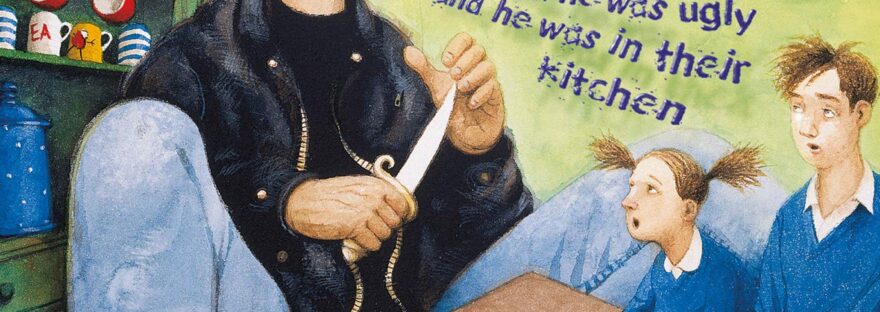By Diana Wynne Jones (published by Harper Collins Children’s Books)
“Who is Archer?” said Howard.
The Goon shrugged his huge shoulders. “Archer farms this part of town. Your dad pays, Archer doesn’t make trouble.” He grinned, almost sweetly, and sucked the last bit of bread off the point of his knife. “Got trouble now. Got me.”
As the Autumn equinox slips away and the nights start getting longer, I find myself reaching more for comfort books; books that I know and love, that have engaging, magical storylines and bright, vibrant characters. And one of the best at that, for me, is Diana Wynne Jones.
Archer’s Goon has been a favourite of mine ever since I was a child. Set in an unnamed town in England, it follows 13-year-old Howard Sykes and his family (plus student lodger Fifi) as they discover the tall, broad ‘Goon’ in their kitchen, there to collect the two thousand that someone called Archer is owed by Howard’s father, Quentin.
It quickly comes to light that the two thousand isn’t pounds, but words – Quentin is a writer, who made a deal to write 2,000 words every quarter to alleviate his writer’s block. But the words have gone missing, and for some reason Archer wants a new set. All of a sudden the Sykes family find themselves beset by not only Archer but his powerful siblings too, all of whom want to know why the words might be important and what they could do with them if they got hold of them…

The story carefully balances realism with fantasy, and although there is some kind of magic at play (in what is otherwise a normal world), each story beat follows the previous with logic, making it relatively easy to follow the action. (Note: the book avoids the term “magic”, or anything associated with it such as “wizards”.)
Some of the fantastical elements remain unexplained by the end of the book, such as the origins of the mysterious siblings, but the story doesn’t feel incomplete without them; rather, I suspect that it would drag if Jones had included those details as well.
As it is, the story flows seamlessly and at a pace that feels realistic; exciting chases and encounters are also sprinkled with quieter moments where the characters can breathe or regroup. Considering how children’s books can sometimes bounce straight from one thing to the next, I find the time for reflection good – especially since some of the ideas and events can take a minute to wrap your head around – though others may wish it would pick up the pace.
Howard’s family, comprising of Quentin, mum Catriona and little sister Awful (actual name Andrea), feels like any family you might know; they may have their arguments, but they are always there for each other, and the banter between them feels genuine. Everyone is imperfect in their own ways, but their dynamic together makes for excellent reading.
The mysterious siblings are the opposite of the Sykes. Each one (there are seven in total) “farms” or runs a certain part of the town – for example, Archer runs the banks and power companies, Shine handles crime, etc. It is obvious from the way they talk about each other that they merely tolerate each other, and their greed, egotism and disdain feel somewhat fitting for beings with their level of power. Even so, they are an intriguing group, and it’s fun to try to work out what part each plays in the story.
Despite having a broad cast of characters – the Sykes family, the siblings who run the town, the Goon and Fifi, plus Shine’s lieutenant Ginger Hind – every single one is fully fleshed out with their own motivations, schemes, beliefs and opinions on what’s going on.
Jones’ descriptions throughout the book are simple but effective, easily conjuring up an image of the action; from the way Catriona locates each family member by their noises, to the reflection of each sibling’s character in their surroundings, even to the splart-thump of the soggy hole in Howard’s boot.
The reveal of what’s actually going on in the town and with the missing words makes this a story that is well worth reading a second (or third!) time, so you can spot all the hints and piece together the clues – they’re subtle enough to miss on a first reading, but they are definitely there.
The book is not perfect of course, and there are a couple of notes in particular that stand out reading it as an adult (the reasoning behind Fifi’s final actions in the book, and a couple of moments which feel somewhat like fatphobia spring to mind), but in general, the book is an appropriate read for older children.
Overall, Archer’s Goon is a witty, fantastical tale about family and identity, the difficult choice between doing what’s right and what’s easy, and how to stop a group of magical megalomaniacs from taking over the world.
If you like the sound of Archer’s Goon, you can grab a copy at the link below.
(Disclosure: If you buy books linked to our site, we may earn a commission from Bookshop.org, whose fees support independent bookshops.)
Looking for more fantastical tales to read? If so, you can check out some of our previous fantasy reviews here.

